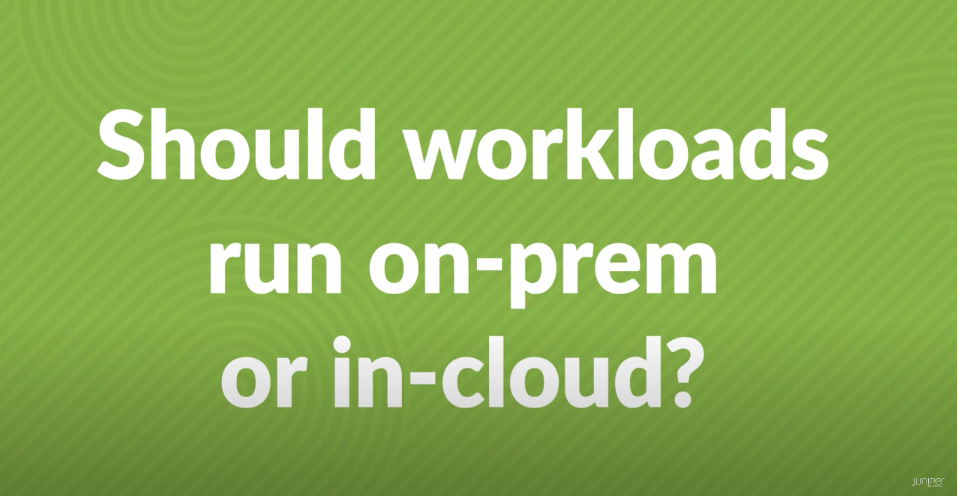Today's Network Operations Are AI-Ops


Self-driving networks are the future of IT.
In this final video in a series focusing on IT services (see parts one and two ), Juniper’s Edward Wustenhoff discusses AI-Ops, including how he defines it and what it means to him. Don’t miss this short, eye-opening video filled with real-world examples of how Juniper Marvis can dramatically improve network operations and help you successfully manage the availability, security, performance, and economics of your IT infrastructure.
You’ll learn
Why Edward believes we will have self-driving networks before we have self-driving cars
The keys to a successful AI-Ops deployment
Who is this for?
Host

Transcript
0:00 [Music]
0:00 foreign
0:00 [Music]
0:05 I'm Edward today's topic is AI Ops and
0:10 what it means to me
0:12 you may remember that I'm a big fan of
0:14 Iron Man and there's a sequence where
0:15 Tony Stark is engrossed in deep thought
0:18 but certainly Jarvis interrupts and
0:21 refocuses him on something that really
0:23 needs his attention
0:25 that for me is a great example of the
0:28 essential function that artificial
0:30 intelligence should bring to it
0:33 it relates to iot and how that's so
0:36 different from the common internet of
0:38 people
0:39 the key observation is that devices
0:42 create so much more data and there's no
0:44 way people can keep up with it this is
0:47 where we need computers to help
0:49 I Define ai Ops as applying artificial
0:52 intelligence capabilities to manage the
0:55 availability security performance
0:57 economics and change of our
0:59 infrastructure
1:00 the ultimate goal is to allow for
1:02 self-driving networks or infrastructure
1:04 similar to how people talk about
1:06 self-driving cars but we are only at the
1:10 beginning of the capability and I'm
1:12 cautious about the claims being made to
1:15 that extent today
1:16 however when you can limit the number of
1:19 variables and the data the AI has to
1:21 process it is easier to build a
1:24 successful model and the key is to have
1:26 well-defined content which is the case
1:29 in network operations
1:31 this is why I believe we'll have a
1:33 self-driving Network before we have
1:35 self-driving cars
1:37 and today this is why Marvis is so
1:40 successful in helping us operate our
1:42 Network
1:42 let me give you a few examples it
1:45 improves our visibility into our
1:47 wireless network and provides proactive
1:49 resolutions for example we avoid not
1:52 knowing what we don't know it helps us
1:54 find Opportunities to improve
1:56 performance by showing where delays
1:58 happen for example just the other day it
2:00 showed us how a certain laptop's very
2:03 specific Wi-Fi device driver did not
2:06 play nice with our Network we now avoid
2:08 problems before they arise by
2:10 proactively creating a pick list of APs
2:13 that need attention it shows us
2:15 potential bad cables authentication
2:17 errors AP Hardware faults or other
2:19 network related issues
2:21 because of this visibility and this
2:24 predetermination of potential causes we
2:27 reduce the number of wireless tickets
2:28 over the last nine months by 42 percent
2:32 which is incredible when you think about
2:34 the fact that we already running a
2:36 Leading Edge Network
2:38 especially at scale this becomes
2:40 critical just think about the challenges
2:43 to resolve issues quickly in a world of
2:45 millions of iot devices thousands of
2:48 Home Offices or tens of thousands of
2:50 retail locations
2:52 and we recently upgraded 2 000 APS
2:55 across the world in a few days the
2:58 actual work of the tech was planning the
3:00 upgrade schedule to minimize the risk
3:02 and impact Marvis did all the work
3:05 the key to a successful AI Ops
3:07 deployment is being able to pierce
3:09 through the hype and test how much work
3:12 is left for humans after the computers
3:14 have done their job this doesn't mean
3:16 less humans but with Marvis keeping the
3:18 lights on it allows our team to add more
3:21 value and make more fundamental upgrades
3:23 to the network
3:24 Marvel's ability to analyze the data is
3:27 where we see the biggest benefit today
3:29 I'm not ready to eliminate the human
3:32 interpretation of the ai's observations
3:34 and rely solely on the suggested actions
3:37 for improvement yet however once that
3:41 confidence level is high enough I'll be
3:43 ready to hit the self-driving button
3:47 for our Network we clearly are on the
3:50 way and I expect more exciting progress
3:52 soon so if you would like to add ask or
3:55 a book a live demo let's talk about it
3:59 [Music]



